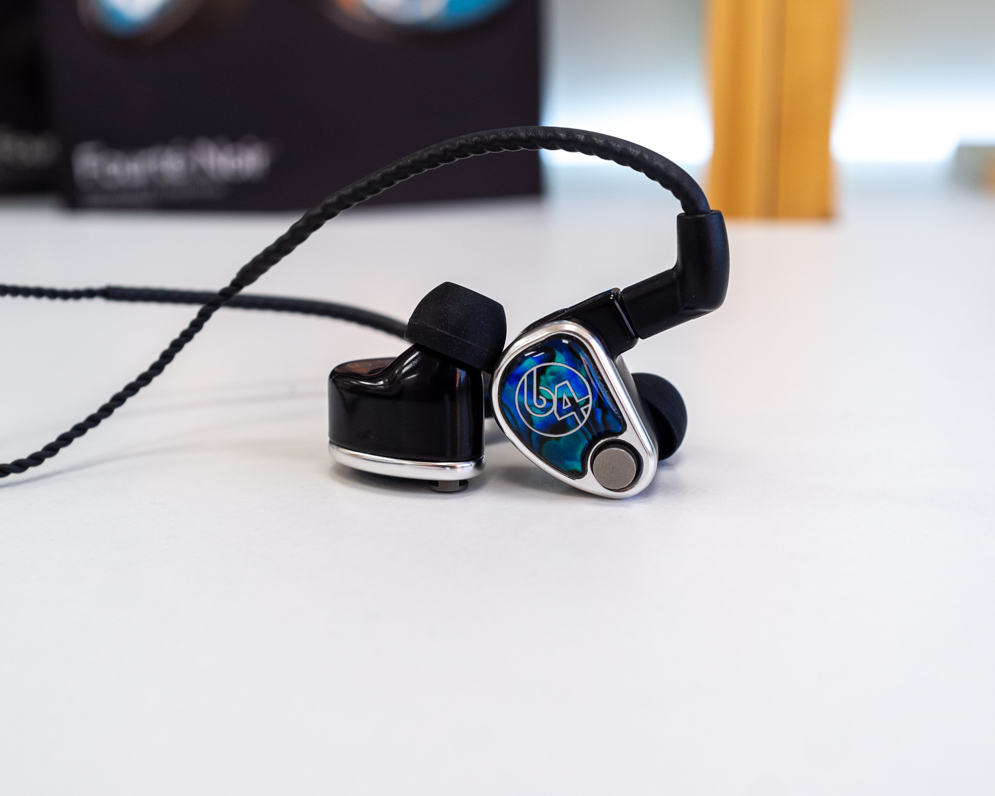64 Audio’s latest hybrid creation give you a bit of everything, from studio neutrality to hard hitting bass, all the while retaining a very refined sound signature.

[jnews_review_shortcode review_show_breakdown=”true”]
Fit and Comfort
The Nio are the same shape as the rest of the 64 Audio universal line-up, which have quite an interesting shape and is a tried and tested design. Offering up smooth edges with a good length nozzle for a secure fit and great comfort. Once you settle on the right size tips for your ear canals, they fit securely with the new included cable being more ergonomic and comfortable.
Compatibility
With high sensitivity (105db dB/mW) and low impedance (6? @1kHz) the Nio are easy to drive out of most sources, and they use 64 Audio’s LID technology which means the sound signature shouldn’t drastically change beween sources. This isn’t to say they don’t benefit from higher end sources though, as things like resolution and detail are important and they definitely scale up with better source equipment.
The Nio use 64 Audio’s apex modules, these help relieve internal ear pressure along with offering different levels of isolation and also slightly different sound signatures. Normally you get an M15 and M20 module, which offer 15dB and 20dB reduction in outside noise respectively, by new for the Nio is the MX module which offers a mere 10dB reduction of outside noise. The more isolation, the more bass is the rough rule of thumb, and the lower the isolation the more open and airy the sound is.
Sound
Bass:
The low end on the Nio is very dynamic and depending on the module used you can range from full bodied to neutral in presence. One thing that always stands out on 64 Audio models is how well controlled and refined the sound is. They can offer up more than enough punch to satisfy most needs but the bass never becomes bloated. It offers a solid foundation for the rest of the sound, and is very articulate. There is great depth to the Nio, and the use of a dynamic driver here works really well here. The M20 module gives you a slight lift in sub-bass and moderately more mid-bass punch over the M15 which is more linear and the MX which is very controlled and not boosted. One thing that stands out here is the coherency and fluidity of which the bass blends in to the midrange.
Midrange:
Depending on the module used the lower midrange changes slightly, with the MX giving the most neutral and least coloured presentation whilst the M20 adds a little body and smoothness to the lower midrange that makes things sound a little fuller. The Nio has excellent control overall and the midrange is crisp and clean, yet tonally accurate. There isn’t any peak in the upper midrange to bring out sibilance, instead you get a linear and intimate insight into the recording. The layering is good and you can easily pick apart the recording without any difficulty. The MX definitely sounds like it reveals a bit more micro-detail over the M20, so it greatly depends on your personal preference.
Treble:
64 Audio are using their usual tia driver up top and these drivers really do offer up excellent resolution and an openness that other BA drivers fall short of. The M20 gives the smoothest sounding treble due to the increased bass response but it still has good presence and resolution. Using the MX still gives the most open and airy treble as would be expected but it never falls onto the side of being harsh or bright. There is refinement up top without sounding too present, yet there is excellent detail retrieval and effortless extension on hand. Overall the treble is always present, allowing the Nio to sound well balanced without any fatigue inducing spikes.
Genres and Soundstaging
The Nio is a superb all-rounder, due to the different Apex modules. The M20 giving you a full bodied sound with good impact while the M15 gives a well balanced and refined sound. In addition, the MX giving a close to neutral presentation without much emphasis on any part of the spectrum. This means they play well with pretty much anything you throw at them, the control down low and the layering means they don’t sound congested with complex mixes either.
The soundstaging varies slightly with the modules, with the MX giving the most air and space. But overall it is wider than it is tall and there is good separation between instruments and layers.
[jnews_review_shortcode review_show_price=”true”]